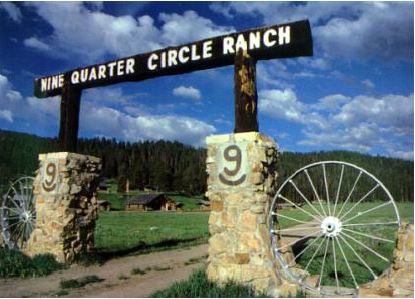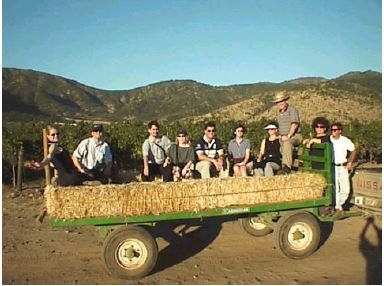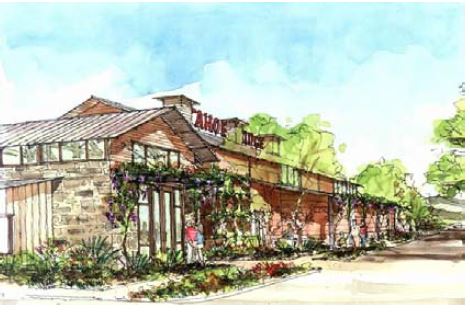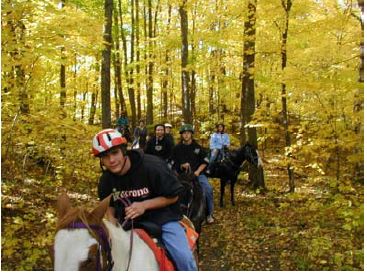Introduction
Agritourism is a fast growing sector of the tourism industry. Agritourism can be roughly defined as rural enterprises which both produce agricultural commodities and serve tourists. Examples include farm tours, dude-ranching, harvesting, educational demonstrations, direct marketing of produce or livestock, hunting, fishing, bed and breakfast-type accommodations, horseback riding, hayrides and last, but not least, wine tasting. Agritourism may hold considerable economic potential for agricultural enterprises in Nevada as well as for rural county economies in general. Agritourism is a niche sector of the larger tourism industry in Nevada.
Nevadans are well acquainted with the power of tourism to provide economic opportunity. Nevada is a state profoundly dependent on the tourism industry, largely in the gaming sector. Thus, even in many rural counties, Nevada already has significant investment in tourism infrastructure and personnel. These assets may be helpful to entrepreneurs interested in developing agritourism attractions. In 2005, roughly 23 percent of all employment in Nevada was in accommodation and food services or arts, entertainment and recreation (U.S. Department of Commerce, 2007). In rural Nevada (excluding Washoe and Clark counties), seven out of 15 counties had more than 1,000 travel and tourism-related jobs in 2005, ranging from one percent of total employment in Eureka County to 41 percent of total employment in Douglas County1. For these 15 counties, tourism related jobs made up 20 percent of total employment (see Table 1). Current

Current income from agritourism in Nevada appears to be modest. In 2002, 55 Nevada farm and ranch businesses in 12 counties reported deriving income from recreational sources, contributing a total of $442,000 (see Table 2). The potential for expanding the income from agritourism in Nevada may exist. Included in Table 2 are several of the Economic Research Service (ERS) indices for Nevada counties, which can influence income potential from agritourism enterprises.
Sources: USDA, National Agricultural Statistics Service, 2002 Census of Agriculture – County Data, “Table 6. Income From Farmrelated Sources: 2002 and 1997”, USDA, Economic Research Service, Measuring Rurality: Urban Influence Codes, USDA, Economic Research Service, Natural Amenities Scale, USDA, Economic Research Service, (D) Withheld to avoid disclosing data for individual farms.
1 Data are from the Nevada Department of Employment, Training and Rehabilitation Quarterly Census of Employment and Wages series. Esmeralda County data on tourism employment is not available due to disclosure rules.

The urban influence code indicates the proximity and size of urban populations to the county, with a 1 indicating the greatest influence from urban populations and an 11 indicating the least influence. A rural county near an urban center has an obvious advantage in attracting customers to certain types of agritourism ventures, such as direct marketing, petting zoos and corn mazes, due to its relatively easy access. On the other hand, new research into data on wildlife-based agritourism involving hunting, fishing or wildlife viewing found that more isolated regions actually generated greater than average revenues, indicating that rural counties with a higher urban influence code (least urban influence) may have special appeal to portions of the wildlife-based tourism market. This is not surprising as those interested in wildlife experiences, such as hunting, fishing and photography value more remote areas as a part of the experience. These types of agritourism customers typically are wealthier and willing to spend more money (Wilson et al., 2006). The 2001 National Survey of Fishing, Hunting and Wildlife Associated Recreation commissioned by the National Fish and Wildlife Service estimated that 657,000 participants in wildliferelated recreation spent a total of $680,000,000 in the state of Nevada. Of this amount, $168,000,000 was estimated to be spent on triprelated expenditures rather than equipment. While equipment purchases are likely made in urban areas, trip-related expenditure is more likely to occur in the destination region.
Table 1. Employment in Tourism Related Sectors in Rural Nevada Counties, 2005
| Area |
Accommodation, Food, Art, Recreation Employment* |
Percent of total |
| Carson City |
4,005 |
12.5% |
| Churchill County |
1,038 |
12.1% |
| Douglas County |
8,885 |
40.8% |
| Elko County |
6,255 |
31.4% |
| Esmeralda County |
** |
- |
| Eureka County |
38 |
1.0% |
| Humboldt County |
1,133 |
15.1% |
| Lander County |
152** |
7.5%** |
| Lincoln County |
82** |
6.5%** |
| Lyon County |
1,370 |
11.2% |
| Mineral County |
98** |
5.7%** |
| Nye County |
2,146 |
17.8% |
| Pershing County |
174 |
9.4% |
| Storey County |
163 |
12.7% |
| White Pine County |
554 |
14.6% |
| Total |
26,093** |
20.1%** |
*Defined as sectors 71 and 72 in North American Industrial Classification System (NAICS).
**Some data missing due to disclosure rules. Source: Data are from the Nevada Department of Employment, Training and Rehabilitation Quarterly Census of Employment and Wages series.

The natural amenity index is another code that combines data on topography, water surface area, temperature and humidity to predict the desirability of a given counties’ natural amenities. The index ranges from 1 to 7 with the higher score indicating more desirability. A 3 or 4 rating indicates average amenity availability. The natural amenity index indicates that Nevada contains highly desirable outdoor amenities such as mountains, low humidity and sunshine. All Nevada counties ranked above average for natural amenities except for Elko and Eureka counties, which lost some points because of colder, more variable weather conditions. High natural amenity rankings were correlated with higher income from wildlife recreation activities.
Finally, the ERS has created a county topology code identifying rural tourismdependent counties by type of recreation. Counties with especially large shares of employment and income from the tourism sector or counties with a high percentage of seasonal vacation housing or high per capita hotel and motel receipts are considered “recreation” counties. The recreation counties are further classified as one of eleven different types. The ERS classified five counties in Nevada as recreation counties (the type of recreation ERS assigned is given in parentheses): Churchill (casino), Douglas (casino), Elko (casino), Storey (miscellaneous) and White Pine (national park). It is clear that Nevada has significant resources both in tourism infrastructure and in natural amenities.
Conclusions
Many rural Nevada counties already have workers, infrastructure, entrepreneurs and marketers with experience in tourism. In addition, many areas of rural Nevada have high natural amenity value. These factors could provide a niche opportunity in agritourism for rural ranchers and farmers. Isolated areas with high natural amenity value may be especially attractive to wildlife-based tourism such as hunting, fishing or wildlife viewing.
Additional Information
The UC Davis Small Farms Center has publications on agritourism and a directory of agritourism sites in California. See UC Davis Small Farms Center.
University of Nevada Cooperative Extension Fact Sheet-05-38 “Agritourism: Opportunity for Farm Diversification in Nevada”. See UNCE.

References
Economic Research Service, U.S. Department of Agriculture. Measuring Rurality: Urban Influence Codes, Washington, D.C.
Economic Research Service, U.S. Department of Agriculture. Natural Amenities Scales, Washington, D.C.
Economic Research Service, U.S. Department of Agriculture. Measuring Rurality: 2004 County Typology Codes, Washington, D.C.
State of Nevada Department of Employment, Rehabilitation, and Training. 2005 Quarterly Census of Employment and Wages. Research and Analysis Bureau: Carson City, Nevada.
U.S. Department of Agriculture. 2002 Census of Agriculture: State of Nevada. National Agricultural Statistics Service, Washington, D.C., 2004.
U.S. Department of Commerce. “Regional Economic Information System,” Bureau of Economic Analysis, Washington, D.C., 2004.
U.S. Fish and Wildlife Service and U.S. Census Bureau. 2001 National Survey of Fishing, Hunting and Wildlife-Associated Recreation.
Wilson, Joshua, Dawn Thilmany and Martha Sullins. “Agritourism: A Potential Economic Driver in the Rural West.” EDR 06-01 Economic Development Report, Colorado State University Cooperative Extension. Department of Agricultural and Resource Economics, Ft. Collins, CO, 2006.
Table 2. Farm/Ranch-Related Recreational Income, Urban Influence Code and Natural Amenity Index for Nevada Counties
| County |
Farms Reporting Recreation Income (#) |
Farm Recreational Income ($) |
Recreational Income/Total Farm Income |
UrbanIn fluence Code 2003 |
Natural Amenity Index |
Recreation County Designation |
| Churchill |
4 |
$28,000 |
0.05% |
5 |
6 |
Recreation (Casino) |
| Clark |
1 |
(D) |
- |
1 |
6 |
- |
| Douglas |
0 |
- |
- |
5 |
7 |
Recreation (Casino) |
| Elko |
9 |
$144,000 |
0.31% |
8 |
4 |
Recreation (Casino) |
| Esmeralda |
0 |
- |
- |
10 |
5 |
- |
| Eureka |
2 |
(D) |
- |
8 |
4 |
- |
| Humboldt |
16 |
$94,000 |
0.16% |
11 |
5 |
- |
| Lander |
1 |
(D) |
- |
9 |
5 |
- |
| Lincoln |
4 |
(D) |
- |
4 |
5 |
- |
| Lyon |
2 |
(D) |
- |
6 |
6 |
- |
| Mineral |
0 |
- |
- |
9 |
6 |
- |
| Nye |
1 |
(D) |
- |
3 |
6 |
- |
| Pershing |
3 |
$6,000 |
0.02% |
7 |
5 |
- |
| Storey |
0 |
- |
|
2 |
6 |
Recreation (Misc.) |
| Washoe |
5 |
$35,000 |
0.19% |
2 |
6 |
- |
| White Pine |
7 |
$115,000 |
0.15% |
9 |
5 |
White Pine (National Park) |
| Carson City |
0 |
- |
- |
2 |
7 |
- |
Curtis, K., Fadali, E., and Harris, T.
2007,
Factors Affecting Agritourism Potential in Rural Nevada,
Extension | University of Nevada, Reno, FS-07-30


